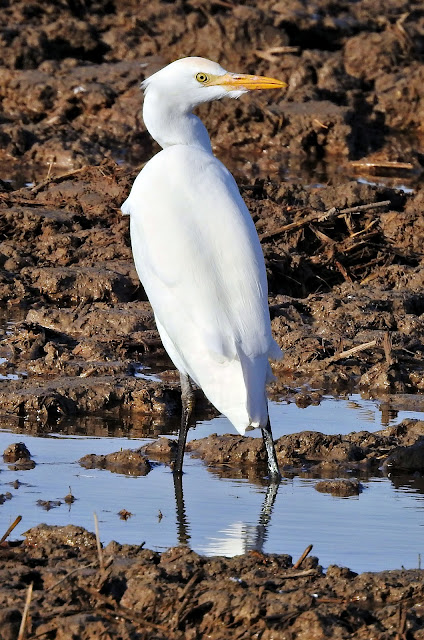The cattle egret (Bubulcus ibis) is a cosmopolitan species of heron (family Ardeidae) found in the tropics, subtropics, and warm-temperate zones. It is the only member of the monotypic genus Bubulcus, although some authorities regard its two subspecies as full species, the western cattle egret and the eastern cattle egret. Despite the similarities in plumage to the egrets of the genus Egretta, it is more closely related to the herons of Ardea. Originally native to parts of Asia, Africa, and Europe, it has undergone a rapid expansion in its distribution and successfully colonised much of the rest of the world in the last century.
It is a white bird adorned with buff plumes in the breeding season. It nests in colonies, usually near bodies of water and often with other wading birds. The nest is a platform of sticks in trees or shrubs. Cattle egrets exploit drier and open habitats more than other heron species. Their feeding habitats include seasonally inundated grasslands, pastures, farmlands, wetlands, and rice paddies. They often accompany cattle or other large mammals, catching insect and small vertebrate prey disturbed by these animals. Some populations are migratory and others show postbreeding dispersal.
The adult cattle egret has few predators, but birds or mammals may raid its nests, and chicks may be lost to starvation, calcium deficiency, or disturbance from other large birds. This species maintains a special relationship with cattle, which extends to other large grazing mammals; wider human farming is believed to be a major cause of their suddenly expanded range. The cattle egret removes ticks and flies from cattle and consumes them. This benefits both species, but it has been implicated in the spread of tick-borne animal diseases.

The cattle egret feeds on a wide range of prey, particularly insects, especially grasshoppers, crickets, flies (adults and maggots), beetles, and moths, as well as spiders, frogs, fish, crayfish, small snakes, lizards and earthworms. In a rare instance, they have been observed foraging along the branches of a banyan tree for ripe figs. The species is usually found with cattle and other large grazing and browsing animals, and catches small creatures disturbed by the mammals. Studies have shown that cattle egret foraging success is much higher when foraging near a large animal than when feeding singly.[58] When foraging with cattle, it has been shown to be 3.6 times more successful in capturing prey than when foraging alone. Its performance is similar when it follows farm machinery, but it is forced to move more. In urban situations, cattle egrets have also been observed foraging in peculiar situations such as railway lines.
A cattle egret will weakly defend the area around a grazing animal against others of the same species, but if the area is swamped by egrets, it will give up and continue foraging elsewhere. Where numerous large animals are present, cattle egrets selectively forage around species that move at around 5–15 steps per minute, avoiding faster and slower moving herds; in Africa, cattle egrets selectively forage behind plains zebras, waterbuck, blue wildebeest and Cape buffalo. Dominant birds feed nearest to the host, and thus obtain more food.
The cattle egret sometimes shows versatility in its diet. On islands with seabird colonies, it will prey on the eggs and chicks of terns and other seabirds. During migration, it has also been reported to eat exhausted migrating landbirds. Birds of the Seychelles race also indulge in some kleptoparasitism, chasing the chicks of sooty terns and forcing them to disgorge food.
A conspicuous species, the cattle egret has attracted many common names. These mostly relate to its habit of following cattle and other large animals, and it is known variously as cow crane, cow bird or cow heron, or even elephant bird or rhinoceros egret. Its Arabic name, abu qerdan, means "father of ticks", a name derived from the huge number of parasites such as avian ticks found in its breeding colonies. The Maasai people consider the presence of large numbers of cattle egrets as an indicator of impending drought and use it to decide on moving their cattle herds.
The cattle egret is a popular bird with cattle ranchers for its perceived role as a biocontrol of cattle parasites such as ticks and flies. A study in Australia found that cattle egrets reduced the number of flies that bothered cattle by pecking them directly off the skin. It was the benefit to stock that prompted ranchers and the Hawaiian Board of Agriculture and Forestry to release the species in Hawaii.
Not all interactions between humans and cattle egrets are beneficial. The cattle egret can be a safety hazard to aircraft due to its habit of feeding in large groups in the grassy verges of airports, and it has been implicated in the spread of animal infections such as heartwater, infectious bursal disease, and possibly Newcastle disease.

Some populations of cattle egrets are migratory, others are dispersive, and distinguishing between the two can be difficult. In many areas, populations can be both sedentary and migratory. In the Northern Hemisphere, migration is from cooler climes to warmer areas, but cattle egrets nesting in Australia migrate to cooler Tasmania and New Zealand in the winter and return in the spring. Migration in western Africa is in response to rainfall, and in South America, migrating birds travel south of their breeding range in the nonbreeding season. Populations in southern India appear to show local migrations in response to the monsoons. They move north from Kerala after September. During winter, many birds have been seen flying at night with flocks of Indian pond herons (Ardeola grayii) on the south-eastern coast of India and a winter influx has also been noted in Sri Lanka.
Young birds are known to disperse up to 5,000 km (3,000 mi) from their breeding area. Flocks may fly vast distances and have been seen over seas and oceans including in the middle of the Atlantic.





%201.jpg)











%201.jpg)
%202.jpg)


%201.jpg)
%202.jpg)
%20COURTESY%20VALERIE%20FISHER%201.jpg)



%201.jpg)




%201.jpg)

%201.jpg)
%202.jpg)
%203.jpg)









